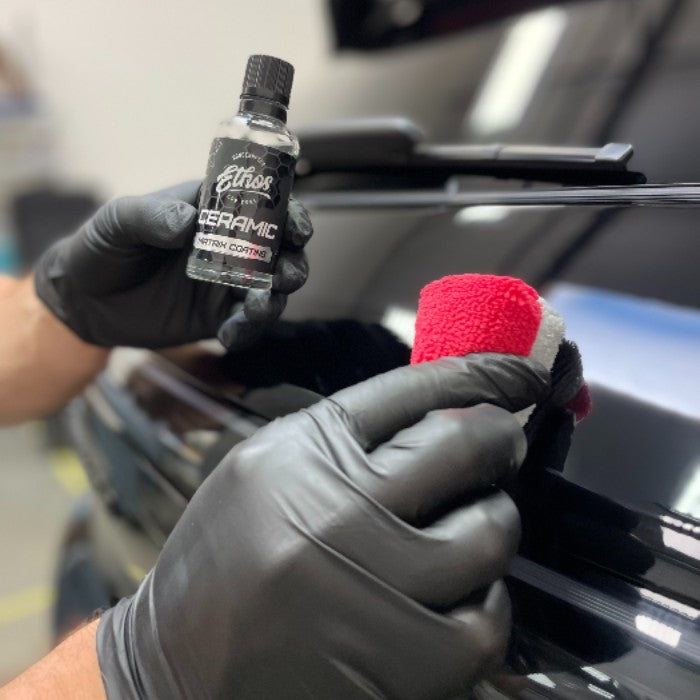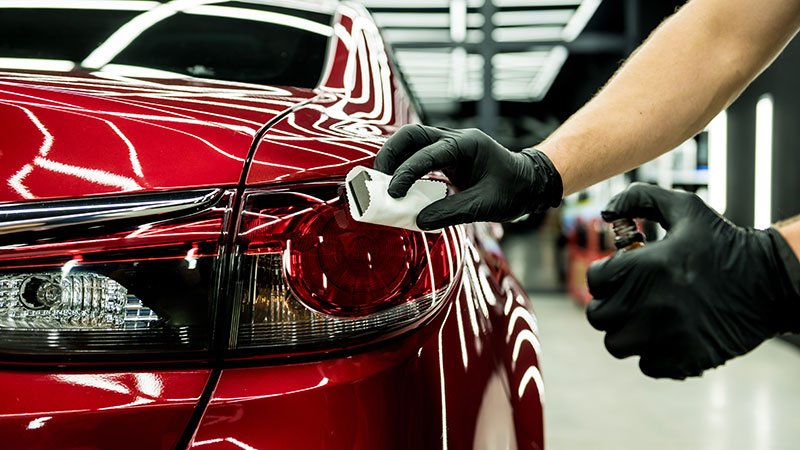Exploring the Scientific Research Behind Car Ceramic Coating and Its Protective Properties
The scientific research of car ceramic coating offers an interesting research study in innovative vehicle defense. Made up primarily of silicon dioxide and polymers, these coverings develop a robust bond with vehicle paint. This communication improves longevity versus ecological hazards while offering hydrophobic advantages. The intricacies of how these coatings work and their lasting benefits remain less recognized. Ceramic Coating Newark. Unboxing these information exposes why ceramic coatings are becoming a preferred option for automobile treatment
What Is Ceramic Coating?
Ceramic coating is a liquid polymer that chemically bonds to the surface area of an automobile's paint. This sophisticated protective layer enhances sturdiness and provides remarkable resistance to ecological factors. Unlike typical wax or sealants, which offer momentary security, ceramic coverings create a durable guard that can endure harsh problems such as UV rays, acidic contaminants, and severe weather condition. When applied correctly, the coating creates a hydrophobic surface area, causing water to bead and slide off, which assists in preserving the vehicle's tidiness. Furthermore, it offers improved gloss and deepness to the paint, making the car show up more sleek and dynamic. The application procedure normally involves extensive surface area prep work, consisting of cleaning and polishing, to assure peak bonding. Because of this, ceramic finishings are ending up being significantly preferred amongst car fanatics and those seeking to safeguard their investments, guaranteeing to preserve the car's aesthetic charm while decreasing the regularity of maintenance.
The Make-up of Ceramic Coatings
The elaborate formula of ceramic coverings mainly contains silicon dioxide (SiO2), which is acquired from natural resources like quartz and sand. This vital component supplies the foundation for the coating's resilience and safety top qualities. In addition to SiO2, ceramic coverings commonly include various polymers and ingredients that improve attachment, versatility, and resistance to ecological variables. These compounds function synergistically to develop a durable obstacle against contaminants such as dirt, chemicals, and UV rays.Furthermore, some formulas integrate titanium dioxide (TiO2) or various other nanomaterials, which can increase the coating's hydrophobic residential properties, resulting in improved water repellency. The precise composition can vary significantly amongst suppliers, impacting performance and long life. Ultimately, the mix of these aspects culminates in a safety layer that not only improves the aesthetic appeal of cars but likewise serves to prolong their lifespan by shielding the surface area from possible damages.
Just How Ceramic Coatings Job
Recognizing exactly how ceramic finishings function includes exploring their chemical composition, which adds to their safety top qualities. The application procedure is necessary for attaining ideal outcomes, while durability and sturdiness elements determine the coating's performance over time. With each other, these components highlight the benefits and performance of ceramic finishes for vehicle security.
Chemical Make-up Explained
While many car owners look for lasting protection for their automobiles, the chemical structure of ceramic finishes plays a vital role in their performance. These finishings primarily contain silicon dioxide (SiO2), which is acquired from all-natural minerals. This compound develops a solid bond with the automobile's paint, creating a durable, safety layer. Furthermore, several ceramic coverings include titanium dioxide (TiO2), enhancing their hydrophobic properties and resistance to UV rays. The existence of polysiloxanes can even more boost flexibility and longevity. Together, these aspects contribute to the coating's capacity to fend off water, dirt, and impurities, while also supplying a high-gloss finish. Comprehending this chemical structure aids car owners appreciate the durable defense provided by ceramic finishings.
Application Process Summary
Using ceramic coverings involves a thorough process that assures excellent bonding and protection for the vehicle's surface area. Detailed cleaning and decontamination of the car's outside are done to get rid of dust, crud, and previous waxes. This action validates that the surface is without contaminations that might hinder attachment. Following this, the paint is commonly brightened to improve clarity and get rid of any type of flaws. When prepared, the ceramic coating is applied in tiny areas making use of an applicator pad, permitting consistent insurance coverage. The coating is after that left to cure, developing a solid chemical bond with the surface. Correct treating times and problems are important, as they confirm the coating achieves its optimum effectiveness and protective qualities.
Durability and Sturdiness Variables
Ceramic finishes are created to provide long-lasting defense through their advanced chemical make-up, which produces a robust obstacle against ecological impurities. The longevity of these coatings is influenced by variables such as the density of the application, the quality of the product, and the conditions under which the automobile is revealed. Premium great site ceramic coatings can last numerous years, resisting scrapes, UV rays, and chemical spots. Correct maintenance, including routine washing and routine reapplication, can even more boost durability. In addition, ecological variables like climate and direct exposure to contaminants can influence the life expectancy of the coating. On the whole, when applied and kept appropriately, ceramic coverings use exceptional longevity, making them a prominent option for car lovers looking for to preserve their automobile's look.
Hydrophobic Qualities and Water Repellency
Hydrophobic properties are a characteristic of top quality car ceramic finishes, substantially enhancing the car's surface area performance. These finishings produce a molecular bond with the car's paint, causing a surface area that pushes back water successfully. When water comes into contact with a ceramic-coated surface, it grains up and rolls off, decreasing the quantity of liquid that continues to be on the paint. This behavior not just adds to a cosmetically pleasing appearance but also lowers the accumulation of contaminants such as dirt, grime, and road salts.The improved water repellency results in easier cleansing and maintenance, as less initiative content is needed to eliminate unwanted materials. Furthermore, the hydrophobic nature of ceramic finishings helps in preventing water places, which can mar the surface of uncoated surfaces. Overall, the unification of hydrophobic residential or commercial properties in ceramic finishes plays an essential role in maintaining the vehicle's pristine appearance while streamlining upkeep.
Protection Versus Scratches and UV Damage
Car ceramic coverings supply considerable protection against scrapes and UV damages. The scratch resistance device produces a sturdy layer that takes in influences, while the UV shielding benefits aid preserve the lorry's paint stability with time. Together, these features add to a longer-lasting and aesthetically enticing surface.
Scratch Resistance Device
Using advanced technology, ceramic coverings provide a durable shield against scrapes and UV damages, improving the durability and appearance of lorry surfaces. The scrape resistance system of these finishings is connected to their one-of-a-kind molecular framework, which forms a long lasting bond with the car's paint. This bond develops a hard, protective layer that can soak up effects and resist abrasions. Additionally, the smooth surface area of the coating decreases rubbing, making it difficult for impurities to adhere and cause scratches. The chemical make-up of ceramic finishes usually includes nanoparticles that enhance the protective layer, additional boosting its resilience. Subsequently, vehicles treated with ceramic finishes exhibit significantly enhanced scrape resistance contrasted to conventional wax or sealants, ensuring an excellent coating with time.
UV Shielding Advantages
The protective high qualities of ceramic finishings prolong beyond scratch resistance to consist of substantial UV shielding advantages. These coatings develop a robust obstacle that reflects dangerous ultraviolet rays, guarding the car's paint and underlying products. Extended direct exposure to UV radiation can lead to fading, oxidation, and damage of the paint finish. By incorporating ceramic layers, lorry proprietors can efficiently reduce these risks, maintaining the visual appeal and honesty of their automobiles. In addition, the UV blocking buildings contribute to improved long life, decreasing the frequency of painting and maintenance. Ultimately, the integration of ceramic coverings supplies a thorough remedy for securing cars from the harmful effects of sunlight exposure, making sure a sustained, dynamic look in time.
The Long life and Upkeep of Ceramic Coatings

Often Asked Questions
Can Ceramic Coating Be Applied to Any Kind of Automobile?
Ceramic coating can be put on different kinds of lorries, consisting of cars and trucks, vehicles, and motorbikes. Nonetheless, surface area prep work and compatibility with details products are crucial for excellent bond and effectiveness of the coating.
Just How Much Does Ceramic Coating Generally Price?
Ceramic coating commonly costs in between $500 and $2,000, depending on aspects such as lorry size, coating high quality, and professional application. The investment can supply durable defense and improve the lorry's appearance in time.

Is Expert Application Essential for Ideal Outcomes?
The requirement of expert application typically depends upon desired results. Specialists typically assure correct surface preparation and application strategies, bring about suitable bonding and durability of the coating, which might be challenging for inexperienced people to accomplish.
Can Ceramic Coatings Be Gotten Rid Of or Fixed?
Ceramic layers can be gotten rid of or repaired, though the process might require certain solvents or techniques - Ceramic Coating Newark. Correct removal is necessary to stay clear of damage to the underlying surface area, highlighting the significance of specialist assistance for perfect results
Exactly How Does Porcelain Coating Compare to Standard Wax?
The contrast between ceramic coating and traditional wax exposes that ceramic coverings use superior sturdiness, boosted protection against ecological contaminants, and longer-lasting sparkle, while wax requires a lot more frequent application and supplies much less total resistance to damage.